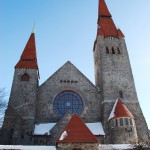Tampere Cathedral (Finland)
The competition for the design of “a new Evangelical church in Tampere” was announced on November 7 of 1899; the deadline for the submittal of the designs was set for October 31 of the following year.
Sonck’s design under the motto Aternitas (Aeternitas (Latin) – Eternity) won the first prize. Altogether there were 23 projects presented; the second and the third places were granted to the designs of the bureau of Grahn, Hedman & Wasastjerna.
The highlights of the winning project were the elegant silhouette and thoughtful design of the temple – for example, the parishioners’ seats were arranged in such a manner that from any spot they could see and hear the priest – two massive columns did not obstruct the view of the altar, because the radial diagonal aisles were made.
The project was ready by December of 1901. According to the project, besides the church a few other smaller buildings were to be built, and against their background, according to the author’s thought, the building of the church would have looked even better. The idea of the ensemble had not been realized, and only the church was built with the fence around it.
The construction began in April of 1902. According to Sonck’s recommendation, Heikki Kaartinen, engineer from Helsinki was appointed the head of the construction, and Birger Federley, who had worked with Sonck before, was appointed the construction’s architect overseer.
The granite was ordered from the company “Kivilouhimo” in Uusikaupunki. The stone was transported from Messikylä and Kuru on barges, and the biggest blocks – weighing 10-15 tons – by horses from Pinsiö. The granite was processed in different ways: the walls are made of scabbled stone; portals, steps, and plinth – of sawed stone, and only a few details of the altar are polished, in particular – the railings.
In spring of 1904, the works on the roof began. The steel framework for the main spire was manufactured by a joint stock company «Tampereen Rautateollisuus» («Tampere Steel Industry»). The height of the main spire is 64 meters, the middle one – 43 meters, and the smallest one – 38 meters. Special tile was ordered to cover the roof from Ylistaro.
The interior works started with the installation of the granite columns and building the vault 16×16 meters, the construction of which was fraught with significant difficulties.
The interior of the church is decorated by frescoes and paintings. The frescos and paintings on the subject of Apocalypses (the church is dedicated to Saint John the Evangelist) were executed by artists Hugo Simberg. The author of the altarpiece fresco “The Resurrection” and of the stained glass window above the altar is artist Magnus Enckell.
The carpentry work (doors, pews) was carried out by JSC Tampereen Höyryppuuseppä, stone carving was done by masters from Estonia – Nicolai Andreev and Lambert Kaivanto, the handles and other brass fixtures were made by ironsmith Taavi Malin.
The 50-register organ was made by Master Albanus Yerva in Lahti. In 1929, the organ workshop from Kangasala added 18 more registers. This instrument is considered to be the best “Romantic” organ in Finland.
Three brass bells for the bell tower architect Joseph Steinbeck bought in Germany, at the foundry of Franz Shilling.
The church utensils were designed by Eric O. B. Ernström; ornaments carved on wood and brass engravings – by Valter Jung; lamps – by Max Friedlander; furniture in the sacristy and in the cellar room for gatherings – by Lars Sonck.
The temple impresses not only by the architecture, but also by its entire decoration. Not only is the sight engaged in this impression, but the hearing too – the building has wonderful acoustics. According to Paula Kivinen, “in this church the message of Christ definitely reaches the listener.”
The construction lasted for five years and three and a half months, and it was finished in spring of 1907. The church was consecrated on May 19 of the same year by Bishop Herman Råbergh from Porvoo diocese.
In 1924, when the Tampere diocese was formed, the church of Saint John became a bishopric cathedral.
The five-year long labour of the country’s best masters gave form to the most valuable assets inherited from the past and rediscovered by the National Romantic Style. The Cathedral of Saint John is not only the pride of Tampere, but, according to the widely held view, is the chief monument of this style in Finland.
This material is taken from the web-resource: http://finmodern.narod.ru

